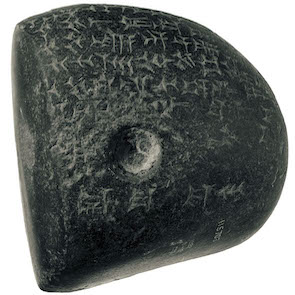Aššur, Part 2
68 [/rinap/rinap4/Q003297/]
A stone door socket discovered north of Temple A in Aššur bears a short inscription dedicated to the god Aššur. The text is similar to text no. 69 (EŞ 7137).
Access Esarhaddon 68 [/rinap/rinap4/Q003297/]
Source:

BM 115703 (text no. 68), a stone door socket of Esarhaddon from Aššur with a dedicatory inscription.
Bibliography
69 [/rinap/rinap4/Q003298/]
A broken basalt door socket from Aššur bears a short inscription dedicated to the god Aššur. The inscription is similar to text no. 68 (BM 115703). This text is commonly referred to as Aššur H (Ass. H).
Access Esarhaddon 69 [/rinap/rinap4/Q003298/]
Source:
Bibliography
70 [/rinap/rinap4/Q003299/]
An inscription on a translucent alabaster amphora from Aššur that had been taken as booty from Sidon indicates that it belonged to Esarhaddon. This text and the following inscription are commonly referred to as Aššur D (Ass. D).
Access Esarhaddon 70 [/rinap/rinap4/Q003299/]
Source:
Commentary
An image of a lion is incised to the left of the inscription, facing the beginning of the inscription. In the repertoire of Assyrian hieroglyphs (text no. 115), the lion may represent "king"; see text no. 115 for further details.
Bibliography
71 [/rinap/rinap4/Q003300/]
An inscription on a translucent alabaster amphora from Aššur that had been taken as booty from Sidon indicates that it belonged to Esarhaddon. This text, like the previous inscription, is commonly referred to as Aššur D (Ass. D).
Access Esarhaddon 71 [/rinap/rinap4/Q003300/]
Source:
Commentary
The cuneiform inscription is incised on the upper surface of the rim of the vessel. Around the body of the vessel is a hieroglyphic Egyptian inscription that probably dates to the reign of 23rd-Dynasty king Osorkon III (ca. mid-eighth century BC). Takelot III, Osorkon's son and immediate successor, appears to have dedicated the inscribed vessel while he was still a prince, as indicated by his titulary. The Egyptian text reads: "Returning from Bahiriya have I come, with all good grapes. O Foremost(?) savior of ka-spirits, may you give them to the one who has any want or care [...] for the ka-spirit of the prophet of Herishef, King of the Two Lands, the chief of Persekhemkheperre, the royal son of Ramses, the general and leader, Takelot, whose mother is Tentsa, the justified." The first cartouche (on the right) is largely illegible and the second cartouche (on the left) reads: "Herishef, King of the Two Lands." I thank Robert Ritner and Jennifer Houser Wegner for providing me with an up-to-date translation of the Egyptian text and cartouches.
Bibliography
72 [/rinap/rinap4/Q003301/]
A fine alabaster vessel from Aššur reportedly bears a one-line inscription containing the name of Esarhaddon.
Access Esarhaddon 72 [/rinap/rinap4/Q003301/]
Source:
Commentary
An image of a lion is incised next to the one-line inscription, which is apparently slightly damaged. This vessel is presently held in the collections of the Istanbul Archaeological Museum, and the author was unable to examine it. The inscription is not visible on the published photograph. For the contents, compare text nos. 70–71.
Bibliography
73 [/rinap/rinap4/Q003302/]
A fragmentary inscription on an alabaster vessel from Aššur bears an inscription of Esarhaddon.
Access Esarhaddon 73 [/rinap/rinap4/Q003302/]
Source:
Commentary
This fragment was originally thought to belong to the reconstructed vessel VA Ass 2255 (Ass 185), which bears an essentially complete inscription of Sennacherib's wife Tašmētu-šarrat (von Bissing, ZA 46 [1939] pp. 153–155). However, the contents of the inscription on Ass 185a make it likely that this object should be assigned to the reign of Esarhaddon. The text was not available for study. For the contents, compare text nos. 70–71.
Bibliography
74 [/rinap/rinap4/Q003303/]
A piece of onyx bears a proprietary inscription of Aššur-etel-ilāni-mukīn-apli (Esarhaddon). The text is a slightly longer version than what is found in following text. This text and the following inscription are commonly referred to as Aššur F (Ass. F).
Access Esarhaddon 74 [/rinap/rinap4/Q003303/]
Source:
Bibliography
75 [/rinap/rinap4/Q003304/]
Three stone amulets (exs. 1–2 and 4) and a piece of lapis lazuli (ex. 3) bear duplicate inscriptions indicating that they belonged to Aššur-etel-ilāni-mukīn-apli (Esarhaddon). This text, like the previous inscription, is commonly referred to as Aššur F (Ass. F).
Access the composite text [/rinap/rinap4/Q003304/] of the score [/rinap/scores/Q003304/score] of Esarhaddon 75
Sources [/rinap/scores/Q003304/sources]:
Bibliography
76 [/rinap/rinap4/Q003305/]
An inscription written on an unbaked clay tablet from Aššur describes Esarhaddon's work on Ešarra, the temple of the god Aššur at Aššur. The text is written in a literary style like a poem.
Access Esarhaddon 76 [/rinap/rinap4/Q003305/]
Source:
Commentary
The tablet was discovered in a private house in the eastern part of Aššur (iC6III). Based on the contents of other documents in this building, Ass 21506e may belong to an archive and library of a family of chief singers. The excavators photographed only the obverse of the tablet. The edition relies on Borger's edition since the original object could not be located.
Bibliography
Erle Leichty
Erle Leichty, 'Aššur, Part 2', RINAP 4: Esarhaddon, The RINAP 4 sub-project of the RINAP Project, 2025 [http://oracc.org/rinap/rinap4/RINAP4TextIntroductions/Assur/Part2/]